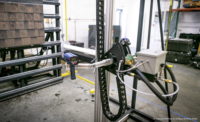Understanding Hail
IBHS' New Hail Data Leads to Better Roofs
The 2024 hail study sets the foundation for improving roofing materials and technology

Earlier this year, 13 researchers with the Insurance Institute of Business & Home Safety traveled over 8,000 miles in the Great Plains for two weeks, setting up equipment in the face of oncoming storms. Their mission? Gather as much data about hail as they can.
What does this have to do with roofing?
Good question! This intensive two-week field deployment will ultimately lead to the creation of better roofing materials that can withstand extreme weather conditions.
Oh, cool! So what did IBHS do during this field study?
The team employed a few different techniques. One is a prototype omnidirectional disdrometer — a wind-driven hail sensor — that measures the impact angle of hail. The team also collected samples that they measured, weighed, and crushed, which will grow their already expansive collection of data on hail.
They also set up small roofs.

The IBHS researchers hauled their equipment across the Great Plains, including Nebraska, Texas and Oklahoma
Wait, what?
For the second year, researchers brought three-foot by three-foot panels installed with shingles into the field. The panels have adjustable legs so they can simulate sloped roofs. Each panel was equipped with impact-rated shingles from one of four or five manufacturers. A few panels had non-impact-rated products for comparison.
Jake Sorber, one of the IBHS researchers heavily involved with the studies, said the shingle panels were born out of a desire to verify that the hail tests IBHS conducts in their labs match up with what Mother Nature dishes out.
This year, they saw more success with the panels by having two teams deploy two panels each to maximize the chances of the shingles experiencing large hail.
“We were pretty successful. We retired 26 panels out of 32 panels with at least marginally severe hail, right around one inch or greater,” he said.
That sounds like a lot of work.
It was! The two teams of researchers spent about 15 days in the field on a nomadic deployment. Working with the National Weather Service, they tracked hailstorms. When a promising storm developed, they drove to the location and quickly set up equipment before taking shelter.
Of those 15 days, Sorber said 10 were operation days, which are days when the teams take measurements from a storm. The previous record was eight days. This year, they observed storms in Nebraska, Iowa, Texas, Kansas, and Oklahoma.
What did they do to figure out the damage the shingles took?
To gain information from damaged shingles, they take before-and-after pictures of the panels. They can then cut out samples and conduct a machine visual analysis to assess the exact levels of denting, granule loss and tears.
Sorber said the more high-tech devices like the disdrometer track kinetic energy flux data (like the angle the hail fell). They can then determine how much kinetic energy a panel experienced and compare that with the damage severity of the panel.
“What that does, looking at kinetic energy flux and accumulated kinetic energy, it bakes in the concentration aspect of the hailstones as well as the size,” Sorber said. “What we see at the lab is that high concentration of sub-severe hail can also do damage to these panels, not just large hailstones.”
That was a lot of science words.
Yeah, but thankfully, Sorber explained it further for us non-scientists. He said studying the kinetic energy is paving the way for a new approach to viewing hailstorm damage.
“So theoretically, the higher the kinetic energy that we get, the more severe the damage will be,” he said.
In addition to more accurate damage assessments, the approach may help radar detection. Sorber said once hail goes beyond two inches in size, it’s hard for radar systems to predict just how big the stones will be. When they found larger stones in the field, they 3-D scanned them, allowing them to analyze something at their leisure that otherwise melts.
“You take these 3-D models of hailstones and apply them to radar applications. So … how do these complex shapes of hailstones affect our ability to detect them?” he said.
Sorber noted that many commercially available hail swath maps have a large margin of error since they use outdated science to detect where hail is falling, so these new approaches could also benefit that technology, giving contractors better tools for serving customers affected by storms.
“What we’re trying to do is move away from these maximum size products, where it’s trying to detect the maximum size of hail … and move more into total kinetic energy,” he said. “Total kinetic energy bakes in size and concentration.”

IBHS deployed roof panels throughout its 2024 study to verify the hail damage data they generate in the lab coincides with real-world conditions.
Nice. So, how exactly is all this data used to help make better roofing materials?
By gaining a better understanding of hail, such as composition, how they form and how they differ by region, IBHS can further improve its testing methods.
All the data IBHS collects allows them to create synthetic hailstones that resemble real-world hail to use in the testing of roofing materials. They load these synthetic hailstones into a CO2-powered gun and fire them at shingles to simulate the speeds hail reaches when striking a roof.
The results provide a much more accurate assessment of how shingles will perform in a hailstorm compared to the traditional method of dropping steel balls. The results are shared with manufacturers, who can determine if further improvements are needed. This includes UL adopting IBHS’ testing methods in 2021.
The testing will go beyond small-scale reproductions, too. Using the data, IBHS can test building materials in a full-scale lab chamber, duplicating hailstorms as close to real-world conditions as possible.
Do we get to see the results of these studies?
Yes. Every two years, IBHS releases its Hail Shingle Rating scorecard, which evaluates impact-rated shingles for their ability to withstand dents/ridges, tears and granule loss. The last refresh took place in 2023, so expect a new scorecard in 2025.

Ian Giammanco, managing director for Standards & Data Analytics and a Lead Research Meteorologist at the IBHS Research Center in Richburg, S.C., sets up a disdrometer, which tracks hail impact angles.
What about commercial products?
“We’ve done a little bit of low-slope testing in the past. Coming up, we’re going to be testing some metal roofing,” Sorber said. “The thing with metal roofing that we’re looking at is, when is cosmetic damage severe enough where you can A) see it from the ground, and B) when does that warrant a replacement of your roof?”
Sorber said this metal roof testing is tentatively scheduled for 2025. In the meantime, contractors can check out IBHS’ Commercial Roofs Best Practices Guide.
This is great and all, but what if I’m more of a visual person?
No problem. IBHS has a short video about this year’s study:
Looking for a reprint of this article?
From high-res PDFs to custom plaques, order your copy today!






